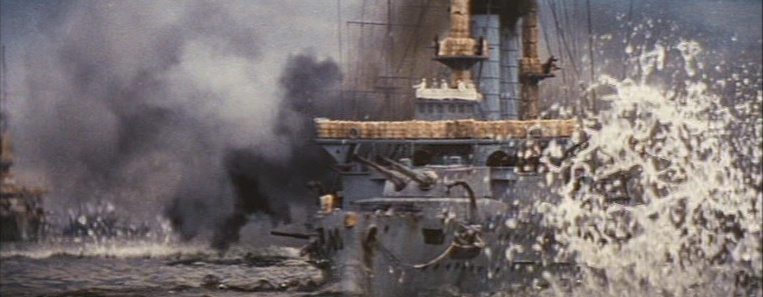
By the late sixties, a number of movies about WWII had appeared featuring heroic characters who had died early in the war – Yamamoto was an especially popular subject – and Toho Studio in particular was looking for ways to use its Godzilla trained special effects unit. After Storm Over the Pacific, they at last turned to the modern war Japan had won, last seen in Shintoho’s The Emperor Meiji and the Russo-Japanese War (1957), the movie that made wide-screen popular in Japan.1 Where Emperor Meiji had concentrated mostly on the long and bloody infantry battles around Port Arthur, Battle for the Sea of Japan depicted the greatest sea battle to occur between Trafalgar and Midway, in the Straits of Tsushima where Japan utterly destroyed the Russian Fleet.
To Europe and America, this was such a long-range war that it seemed of little significance at the time. After the Russian Pacific Fleet had been destroyed in the surprise attack on Port Arthur in 1903, Russia assembled its Baltic Fleet and sailed it slowly around Africa and South Asia, intending to settle into headquarters in Vladivostok. This took more than a year, during which the Japanese navy tried to develop a plan under the command of Admiral Togo, played of course by Toshiro Mifune, who was cast as every admirable Toho admiral in this era. The Russians and any European observers saw the Russians as a fleet that would put the little upstarts in their place, and viewed in retrospect, Euro/Americans tend to view it as a precursor to Japan’s later incursions into Manchuria and China and the attacks of WWII. However (at least in this movie), the Japanese saw it as a battle for the very existence of Japan itself. If Japan’s fleet was destroyed, there would be no way to prevent not only the Russians but also the British, French, Germans, and Americans from doing to Japan what they were doing to China. Thus, for Togo and the Navy, it was a very tense situation, much of which manages to come through in the build-up to the battle itself.
The Russians, both in St. Peterburg and in the fleet command, badly underestimated the Japanese. Russia sent eight battleships against Japan’s four, but Japan’s faster cruisers and an unexpected battle plan caught the Russians at their weak points. Before it was over, Russia had lost all her battleships, all but two of the cruisers, and the war. This in turn led directly to the domestic agitations that would continue until the fall of the Tsar during the next mis-managed war. The overwhelming nature of Togo’s success also gave the Japanese a new belief in their own invincibility, which led to their steady moves to gain land and resources outside Japan on the mainland of Asia. It also demonstrated to all Asians that the Europeans could be defeated by Asians, which led directly to the innumerable nationalist movements across China and southeast Asia. Though the battle is little known in America, it was a real game-changer, a battle that we could genuinely say changed the world.
As might be expected, the cast includes most of the Toho stable. In addition to Mifune, we find Chishu Ryu, Makoto Sato, Yuzo Kayama, Ryutaro Tatsumi, Toshio Kurosawa, and Takeshi Kato, as well as Tatsuya Nakadai as a politician plotting with the Bolsheviks. In the steady but bland hands of Seiji Maruyama, Toho’s primary naval movie director, the movie suffers from the standard problems of Naval Battle movies – lots of scenes of people discussing plans, pointing to maps, or looking through binoculars, and of model ships maneuvering, with lots of noisy explosions of guns and ships exploding in the distance, but very little interest in any particular characters, even Togo himself. There is some genuine suspense as Togo bets all his forces on the Russians taking the route he wants them to take. For someone looking to understand modern history and the development of the attitudes of the Japanese military, it is essential, if simplified, viewing, but for someone looking for an engaging war movie, it comes up as very typical.
¹ Jasper Sharp, Historical Dictionary of Japanese Cinema (Lanham, MD, 2011), p. 283.
Toshiro Mifune also stars as Admiral Heihachiro Togo in Toshio Masuda’s “Battle Anthem” (Umi Yukaba: Nihonkai Dai Kaisen) a 1983 film from Toei with a much more personal take on the story. While it is very different from Kihachi Okamoto’s “Fort Graveyard” (Chi to Suna), the power of music is paramount in each of these films. Set mostly aboard the Togo’s flagship, it is a virtual tour de force of music and special effects. One of the best things about stories concerning the Russo-Japanese War is that unlike World War II films we, as Americans, can root for and side with the Japanese against their enemies.
LikeLiked by 1 person
Pingback: Battle of Port Arthur / Hill 203 / 203 Kochi (1980) | Japanonfilm
Pingback: Imperial Japanese Empire / Great War / Dai Nippon teikoku (1982) | Japanonfilm
Pingback: Battle Anthem / Nihonkai daikaisen: Umi yukaba (1983) | Japanonfilm